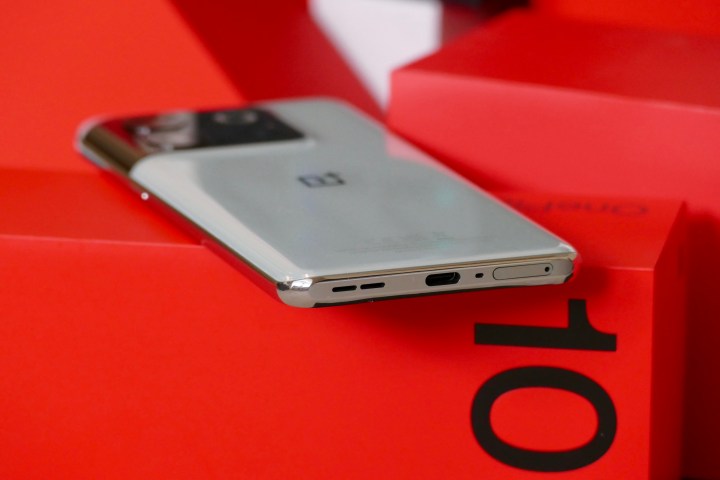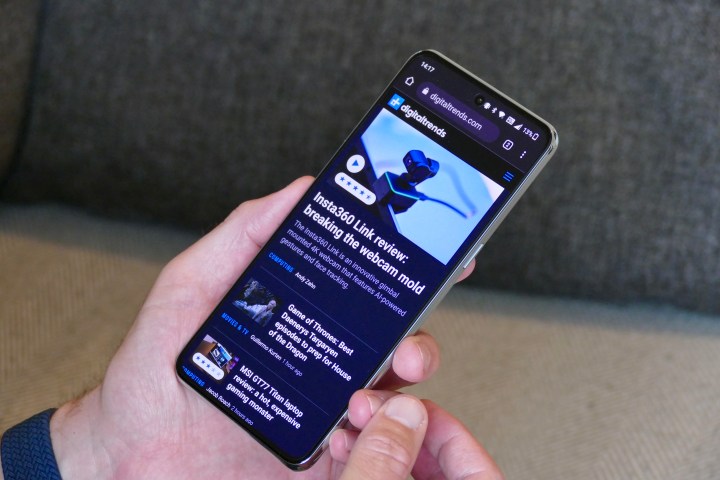The OnePlus 10T bills itself as a cheaper version of the OnePlus 10 Pro. Featuring much the same design, it adds the faster Qualcomm Snapdragon 8+ Gen 1 processor and boasts fast charging at an incredible 150W. It also retails at $649, making it more affordable than its more premium stablemate, which retailed at $899 when it was released in April (but which has now been reduced).
With a starting price of $649, the 10T sits somewhere towards the upper end of the mid-price bracket of smartphones. This category also includes the Nothing Phone 1, which sought to challenge established phone manufacturers in July when it came out with its unique stylings and easy-to-use software. At only 399 British pounds (or about $480), it’s cheaper than the 10T but still qualifies as a competitor. The Nothing Phone 1 has a 6.55-inch OLED screen, 4,500mAh battery, and powerful dual-lens rear camera setup.
It’s hard picking a winner between the two Android handsets, but this head-to-head comparison seeks to do just that. It evaluates the designs, displays, performance, cameras, batteries, and software of each device — and it concludes as to which is superior overall. At the very least, it should help the undecided understand which is the better phone for them.
Specs
| Nothing Phone 1 | OnePlus 10T | |
| Size | 159.2 x 75.8 x 8.3 mm (6.27 x 2.98 x 0.33 inches) | 163 × 75.37 × 8.75mm (6.24 x 2.96 x 0.34 inches) |
| Weight | 193.5 grams (6.84 ounces) | 203.5 grams (7.17 ounces) |
| Screen size | 6.55-inch OLED (120Hz) | 6.7-inch Fluid AMOLED (120Hz) |
| Screen resolution | 2400 x 1080 pixels (402 pixels per inch) | 2412 x 1080 pixels (394 ppi) |
| Operating system | Android 12, Nothing OS 1.1.0 | Android 12, OxygenOS 12.1 |
| Storage | 128GB, 256GB | 128GB, 256GB |
| MicroSD card slot | No | No |
| Tap-to-pay services | Google Pay | Google Pay |
| Processor | Qualcomm Snapdragon 778G+ | Qualcomm Snapdragon 8+ Gen 1 |
| RAM | 8GB, 12GB | 8GB, 16GB |
| Camera | 50-megapixel wide, 50MP ultrawide, 16MP front | 50MP wide, 8MP ultrawide, 2MP macro, 16MP front |
| Video | 4K at 30 frames per second, 1080p at 60 fps | 4K at 30/60 frames per second, 1080p at 30/60 fps |
| Bluetooth version | Bluetooth 5.2 | Bluetooth 5.3 |
| Ports | USB-C | USB-C |
| Fingerprint sensor | Yes, in-display | Yes, in-display |
| Water resistance | IP53 | IP54 |
| Battery | 4,500mAh
Fast charging (33W) Wireless charging (15W) Reverse wireless charging (5W) |
4,800mAh
Fast charging (150W) |
| App Marketplace | Google Play Store | Google Play Store |
| Colors | Black and White | Moonstone Black and Jade Green |
| Price | ~$480 | $649 |
| Review score | 3.5 out of 5 stars | 3 out of 5 stars |
Design, display, and durability

While the OnePlus 10T looks more or less identical to the OnePlus 10 Pro, the Nothing Phone 1 is unlike any phone you’ve ever seen before. Sure, it has a punch-hole selfie lens in the top-left corner of its display, but it also happens to have a transparent glass rear. Not only does this mean you see its internal components, but you also have Nothing’s Glyph LED lights to entertain you, seeing as how they light up in various ways in response to calls and/or notifications. Yes, some people will find all of this a bit much, but at a time when most smartphones occupy almost the same design space, the Nothing Phone is a breath of fresh air.
In addition, the Nothing Phone also has a more premium feel than the OnePlus 10T. That’s because it benefits from an aluminum frame, while the 10T is housed in a plastic chassis (with a glass front and rear). The 10T’s use of plastic gives it a cheaper feel than the Nothing Phone, undercutting any sense that it’s a more expensive device.
On the other hand, the OnePlus 10T does provide a superior display. It carries a 6.7-inch Fluid AMOLED screen, with a resolution of 2412 x 1080 pixels. This is basically the resolution you get with the Nothing Phone, although its 6.55-inch display uses an OLED rather than an AMOLED panel. As a result, it doesn’t quite offer the rich colors and dynamic contrasts of the 10T, despite both devices also supporting a 120Hz refresh rate.
In terms of durability, each phone uses Gorilla Glass 5 on its fronts and rears. The Nothing Phone 1 is certified with an IP53 water-and-dust resistance rating, while the OnePlus 10T manages a slightly higher IP54 (indicating fractionally greater water resistance).
Winner: Tie
Performance, battery life, and charging

The OnePlus 10T runs on the powerful Snapdragon 8+ Gen 1, a 4nm processor which is even more capable than its immediate predecessor, the Snapdragon 8 Gen 1. Coupled with 8GB of RAM (or 16GB if you’re paying more), it makes the OnePlus 10T a very speedy machine. The same isn’t entirely true for the Nothing Phone, since while it benefits from 8GB (or 12GB) of RAM, it houses the Qualcomm Snapdragon 778G+. This is a 6nm chip, and while it’s decent enough on most tasks, we have found that it struggles with more computationally intensive games.
Both the OnePlus 10T and the Nothing Phone 1 offer 128GB of internal memory as standard and both can be had with 256GB. Neither includes a microSD card slot, which may be disappointing to any avid photographers and/or downloaders.
In terms of battery size, the two devices aren’t that far apart. The OnePlus 10T carries a 4,800mAh battery and the Nothing Phone 1 comes with its 4,500mAh cell. This doesn’t seem like a big divergence, yet in reality, the OnePlus lasts considerably longer before you need to recharge it — surviving a day and a half (as opposed to around a day with the Nothing Phone). On top of this, OnePlus’s device supports 150W fast charging (or 125W in the U.S.), something which will take you from flat to 100% charge in about 20 minutes. This is pretty incredible, and it’s something the Nothing Phone simply can’t touch.
Winner: OnePlus 10T
Cameras

The OnePlus 10T has a triple-lens rear camera setup, including a 50-megapixel main lens with an 8MP wide-angle lens and a 2MP macro camera. With the Nothing Phone 1, users get a dual-lens array, featuring a 50MP main lens and a 50MP ultrawide.
It’s always hard to directly compare specs and deduce which phone has a better camera. That said, experience shows that the Nothing Phone 1 edges the 10T overall. Its main lens captures some very well-balanced shots, featuring a vibrant yet natural color palette that doesn’t suffer from oversaturation. Likewise, the main lens of the OnePlus also takes mostly balanced photos, without being quite as vibrant as the Nothing Phone.
Where the phones drift apart is with their respective ultrawide lenses. If you were being harsh, you could argue that the 10T’s ultrawide camera is there simply as a selling point, given that it doesn’t capture much detail and results too often in slightly washed-out photos. With the Nothing Phone, the ultrawide lens can be used to snap very shareable pics, and even if it doesn’t quite equal its main lens, it can be used very well in the right hands.
Winner: Nothing Phone 1
Software and updates

The OnePlus 10T runs on OxygenOS 12, which is OnePlus’s Android 12 skin. Likewise, the Nothing Phone 1 also runs on its own version of Android 12, Nothing OS. The latter is probably one of the best versions of Android available now, which is certainly good going for an entirely new system. It’s remarkably free from bloatware and unnecessary apps or features, something that frees it up to run smoothly.
This contrasts slightly with OxygenOS, which is still pretty snappy and reliable but also has a few teething problems. As our review of the OnePlus 10T found, these include a tendency to show old ahead of new notifications, an overzealousness for showing system notifications (which can overcrowd the notification shade), and also a few bugs that undermine its practicality (such as not showing an option to change the USB-C port from charge mode to transfer data mode).
All in all, OxygenOS certainly isn’t a bad operating system, but it doesn’t impress as much as Nothing OS. Both devices promise three core software updates, so given that Nothing OS is a slicker system overall, the Nothing Phone snatches the win here.
Winner: Nothing Phone 1
Special features

Probably the first thing everyone notices about the Nothing Phone 1 are the lights hidden under its transparent glass rear. Nothing refers to these as the phone’s Glyph Interface, which combines said lights with various sounds and haptics that respond differently to notifications and events. Some might regard such a feature as a big gimmick, but it at least adds an element of distinctiveness to the phone, while also making sure you don’t miss an important text or call.
Sadly, the OnePlus 10T lacks such a unique special feature. It sheds the one hardware feature that had served to distinguish to distinguish its predecessor from the crowd. This is the alert slider, which you could find on every previous OnePlus phone, and which lets mute notifications or put them into vibrate mode.
Its absence is a definite loss for the 10T, although it does come with a consistent in-screen fingerprint sensor, 5G support (although not mmWave 5G), and the aforementioned 150W charging. For its part, the Nothing Phone 1 also supports 5G networks, and it has a decent in-display fingerprint sensor.
Winner: Nothing Phone 1
Price and availability
The OnePlus 10T starts at $649 for the model with 8GB of RAM and 128GB of memory. It can be pre-ordered from OnePlus beginning September 1 in the U.S.
The Nothing Phone 1 begins from 399 pounds (about $480 USD) for the 8GB/128GB model. It’s available in the U.K, parts of Europe, Japan, and India, but not in the U.S., unfortunately.
Overall winner: Nothing Phone 1

It may be nearly $200 cheaper than the OnePlus 10T, but the Nothing Phone 1 is a more rewarding device overall. It boasts a more striking design, a more useful camera system, very user-friendly software, and a novel special feature. Yes, the OnePlus 10T does bring superior performance, faster charging, and a more vivid display, but it ultimately doesn’t do quite enough to justify being significantly more expensive.



